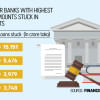The case for expanding bank deposit insurance in Bangladesh

Every day, news headlines highlight the precarious financial health of our local banks. Reports of looming bankruptcies often trace back to the growing burden of unrecoverable "bad loans."
Simply put, bad loans are those that are unlikely to be repaid, either on time or at all. This creates a significant challenge for banks, as their core business relies on lending to individuals and businesses, expecting repayment of the principal along with interest within a set period. These funds are sourced from customer deposits made to the bank for safekeeping or investment purposes. When borrowers default entirely, the financial stability of the banks is severely undermined, threatening the very foundation of their business model.
Currently, all scheduled bank deposits are insured by the Deposit Insurance System, an initiative by the Bangladesh Bank to insure customer deposits up to Tk 100,000. This essentially means that if a bank becomes insolvent or bankrupt, customers may recover up to Tk 100,000 of their money, regardless of how much they had deposited.
For example, if X had Tk 500,000 in a bank that went bankrupt, X would only be entitled to recover Tk 100,000 out of the Tk 500,000 deposited.
However, once the bank is liquidated, whatever funds are recoverable will be used to pay off creditors and shareholders. After that, if any funds remain, they will be used to pay the remaining depositors on a proportionate basis, depending on their deposited amounts.
Now would be a good time to clarify that NBFIs (Non-Banking Financial Institutions) are not covered by this scheme, which essentially means that NBFI customers would lose all their deposits and would not be able to recover anything if the NBFI went bankrupt.
For customers of a scheduled bank that goes bankrupt, the Tk 100,000 is paid out of the Deposit Insurance Trust Fund (DITF), which is managed by the Bangladesh Bank Trustee Board. This fund takes contributions from scheduled banks on a biannual basis based on their financial health. Essentially, the weaker a bank is financially, the more it has to pay per customer toward the DITF, while the stronger a bank is financially, the less it has to pay per customer toward the DITF, ranging from a 0.08 percent to 0.10 percent premium rate.
For most people, the meagre insurance sum of Tk 100,000 per customer is quite disappointing. This is even more relevant today, as this scheme was enacted some two and a half decades ago.
Back then, in 2000, Bangladesh had an economy with a GDP of $67 billion. In 2024, this has grown to a size of $450 billion (even with conservative estimates, it is around the $400 billion ballpark currently).
Additionally, in the last 20 years, Bangladesh, with a comparatively young population, has enjoyed a healthy average economic growth rate of 5-7 percent, regardless of domestic or global macroeconomic instabilities. Pair this with rampant corruption and uncontrolled inflation, particularly since the Covid lockdowns, and the value of the Tk has depreciated drastically, reducing the purchasing power of our currency.
The insurance coverage of Tk 100,000 per customer is not only insufficient but also unfair, especially in an economic environment where many people are unable to withdraw their hard-earned money due to banks facing liquidity crises. This situation has fostered growing mistrust among the public towards local banks, which is alarming. Banks rely on customer deposits to issue loans and generate interest, which in turn funds their operations. However, the current lack of adequate safeguards undermines confidence in this system.
If we zoom out a bit, each scheduled bank is an integral part of the wider economy. Just one bank failing can cause ripple effects across a nation's financial system. Imagine Bank X, which holds the deposits of just 100 customers. If Bank X goes bankrupt, it will stress the entire financial system directly and indirectly, as a big chunk of funds will be lost from the financial system. Additionally, the deposits that customers lose beyond the Tk 100,000 insurance limit will likely never be recoverable. These funds could have been better utilised if spent on goods and services within our economy, stimulating economic growth via loans to SMEs. Lastly, these lost funds are also a loss to the government itself, as they would have been taxable, contributing to the NBR's revenue.
Expanding the Bank Deposit Insurance net would also be a good preventive measure to counter the risk of a bank run if any weak banks do end up going insolvent. A bank run occurs when all customers of a bank attempt to withdraw their deposits in a short span of time. This can spread panic, as most banks do not hold 100 percent of customer deposits at any given time due to the concept of fractional reserve banking. Fractional reserve banking is a system in which banks are required to hold only 10 percent of their cumulative customer deposits while the remaining 90 percent can be utilised for providing loans and other investments. However, this is a tried and tested method, and it is safe because if banks stopped doing this, the economy would slow down significantly.
The existing deposit insurance framework in Bangladesh, with its outdated coverage limit, no longer reflects the economic realities or the financial risks faced by depositors today. As the country's economy has grown significantly over the past two and a half decades, so too has the volume of individual and institutional deposits. The existing insurance coverage undermines depositor confidence and threatens the stability of the financial system, especially in an era of increasing economic volatility.
Expanding deposit insurance coverage is not just a protective measure for depositors but also a strategic move to bolster the banking sector's resilience and people's confidence in the financial system. It would reduce the likelihood of destabilising bank runs, strengthen public trust in financial institutions, and ensure that customer deposits are safeguarded against unforeseen crises. Moreover, a robust insurance mechanism would contribute to economic growth by encouraging savings and fostering a more stable financial ecosystem.
As Bangladesh continues to develop, it is imperative to update existing financial safeguards to align with the economy's growth trajectory. By increasing the deposit insurance limit and extending its scope to include NBFIs, the country can secure its financial future and ensure greater economic security for its citizens.
Shafqat Aziz is barrister at Lincoln's Inn.
Views expressed in this article are the author's own.
Follow The Daily Star Opinion on Facebook for the latest opinions, commentaries and analyses by experts and professionals. To contribute your article or letter to The Daily Star Opinion, see our guidelines for submission.

 For all latest news, follow The Daily Star's Google News channel.
For all latest news, follow The Daily Star's Google News channel. 










Comments